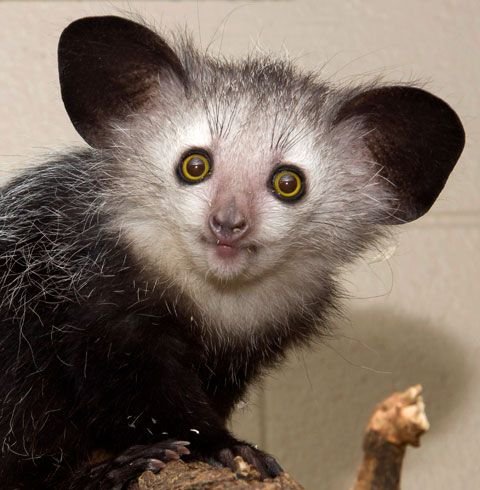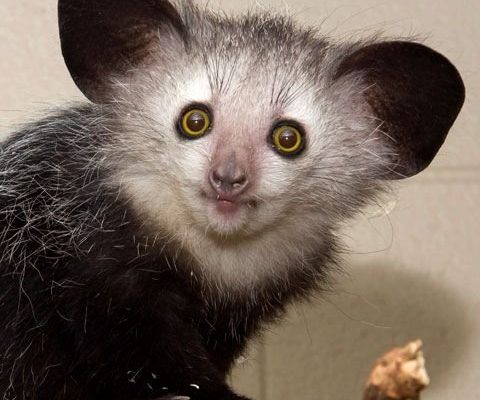
Native to Madagascar, the aye-aye strikes a balance between eerie and adorable. Its looks and behaviors might raise eyebrows, but they play a vital role in its ecosystem. Let’s dive into ten fascinating facts about the aye-aye that will make you appreciate this quirky creature even more.
1. Aye-Aye Appearance
The appearance of the aye-aye is nothing short of striking. It has large, expressive eyes that help it see in dim light, making it a nocturnal superstar. With essentially bat-like ears that can pick up the slightest sounds, this little guy is perfectly equipped for life at night.
But the most eye-catching feature? That long, thin middle finger. Honestly, it looks like something out of a fantasy movie. The aye-aye uses this finger to tap on tree trunks, listening for the telltale sound of grubs hiding inside. Once it zeroes in on its prey, it uses that finger to dig them out! It’s a real-life example of how evolution can come up with some creative solutions.
2. Unique Feeding Habits
One of the most fascinating facts about the aye-aye is its unique feeding technique known as percussive foraging. Imagine a little furry detective, tapping on various trees to uncover delicious snacks. When the aye-aye hears a hollow sound, it knows there’s something lurking inside.
Here’s the thing: this method is not just a quirky habit; it’s essential for survival. By tapping, the aye-aye can locate grubs, insects, and other tasty treats hidden in the bark. Once it finds a meal, it uses its specialized finger to reach in and pull out the goodies. Talk about being resourceful!
3. Aye-Aye’s Habitat
Aye-ayes are native to Madagascar, an island known for its incredible biodiversity. They love tropical rainforests, where they can easily find food and trees to tap. However, their habitat is shrinking due to deforestation and human activity, which is concerning for their future.
The climate of Madagascar contributes to the aye-aye’s lifestyle. They thrive in warm temperatures, which makes their nocturnal lifestyle even more interesting. Despite their shrinking habitat, these primates have adapted well. They’re often found in groups, called “crèches,” which helps them stay safe from predators and provides opportunities for social interaction.
4. Misunderstood Creatures
It’s wild how misinterpretations can affect an animal’s reputation. In Madagascar, the aye-aye is sometimes seen as a bad omen. Local superstitions have led to fear and misunderstanding of this unique creature. Unfortunately, this has resulted in some aye-ayes being killed out of fear.
Here’s a thought: if people took the time to understand the great role aye-ayes play in their ecosystem, they might view them differently. As a key species for pest control, aye-ayes help maintain a balance in their forest habitats. So next time you hear a spooky story about an aye-aye, remember this tiny primate is simply doing its job!
5. Loneliness and Social Structure
Despite their unusual social behaviors, aye-ayes aren’t particularly social animals. They tend to be solitary, venturing out mainly at night to hunt for food. However, this doesn’t mean they don’t have social interactions. When they do come together, it’s often for mating or competing for food.
Interestingly, aye-ayes communicate through a range of vocalizations. Whether it’s a gentle call or a more frantic noise to signal distress, these sounds play a key role in their social life. This makes their nocturnal adventures not just about foraging but also about connecting with others in the darkness.
6. Conservation Status
The aye-aye is currently classified as *Endangered*. Their unique habitat in Madagascar is under threat due to logging, farming, and human encroachment. Conservation efforts are underway to help protect these fascinating creatures.
Organizations are working to raise awareness about the importance of aye-ayes in their ecosystem. Programs aimed at educating local communities about their role in pest control are crucial for the species’ survival. When people understand the value of conserving aye-ayes, it paves the way for a brighter future for them and their habitat.
7. Reproduction and Lifespan
Aye-ayes reach sexual maturity by around three years old. Their mating rituals can be quite elaborate, marked by vocalizations and grooming behaviors. Interestingly, females typically give birth to a single offspring after a gestation period of about 160 days.
Baby aye-ayes are born with soft fur and are dependent on their mothers for several months. They gradually learn about their environment and the unique skills necessary for survival. In the wild, aye-ayes can live up to 20 years, but factors like habitat loss and predation can affect their lifespan significantly.
8. Cultural Significance
In Madagascar, the aye-aye holds cultural significance. Some groups view them as a symbol of misfortune, while others revere them for their uniqueness. This duality shows just how complex our relationships with wildlife can be.
Throughout history, the aye-aye has appeared in various local folklore and stories. These narratives highlight the creature’s mystery and charm, reminding us that even the strangest animals can hold a special place in human culture.
9. Unique Adaptations
The aye-aye is a great example of how evolution shapes an animal’s adaptations to its environment. Apart from its long middle finger, it has sharp teeth that grow throughout its life, similar to rodents. This adaptation helps it tackle tough food and living conditions.
Another remarkable feature is its flexible wrist joint, which allows the aye-aye to tap and dig efficiently. It’s almost as if nature has given it a toolbox of specialized skills! These adaptations make the aye-aye not just a survivor, but a master of its nighttime world.
10. The Aye-Aye in Captivity
Seeing aye-ayes in zoos and conservation centers gives people a unique chance to learn about them up close. In these environments, they often receive better care, and their unique needs can be met more fully.
Captive breeding programs are crucial for the aye-aye’s future, especially with their dwindling numbers in the wild. Education programs in these facilities aim to raise awareness about the importance of conservation. After all, learning about the aye-aye can spark interest and inspire action to save these remarkable little primates!
In closing, the aye-aye is more than just an unusual-looking animal; it’s a vital part of Madagascar’s ecosystem. Understanding its unique traits and challenges emphasizes the importance of conservation efforts. So next time you hear about the aye-aye, remember its quirky features and the critical role it plays in the world. It’s not just a creature of the night; it’s a fascinating marvel of nature!

